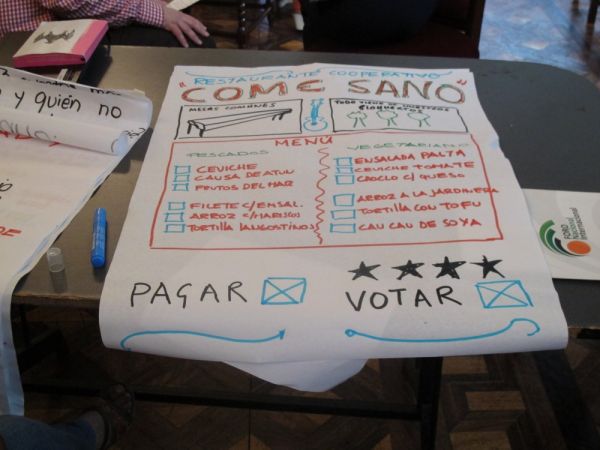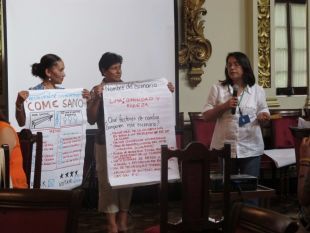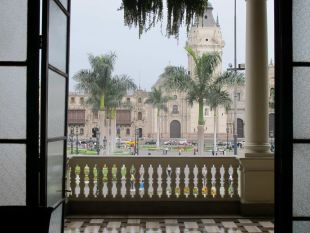Sustainable Transport, Organic Food and Other Visions for 2040

A vision for communal dining in Lima’s future. Photo credit: Manuel Vigo
The Rockefeller Foundation’s Informal City Dialogues project recently completed its first series of workshops in all six of the cities participating. In these initial workshops, attendees were asked to participate in developing “futures” for their city. Please click here to learn more about the process, and find out what will take place in upcoming workshops.
“We don’t have running water or sewage where I live, so you could say we live in a difficult situation,” says Luz, a woman in her late forties. “I’m here to give my son a better future.”
Luz was part of a group of close to 30 Lima citizens who participated in a Futures Scenarios Workshop in late February, part of The Rockefeller Foundation’s Informal City Dialogues. Organized by partners Forum for the Future and the project’s local grantee, FORO Internacional Nacional, the workshop asked Luz and her fellow attendees to answer a simple but powerful question: What will it be like to live in Lima in 2040?

The objective for the two-day conference was to imagine four possible scenarios for Lima in 2040. Photo credit: Manuel Vigo
To tackle the question, participants were asked to enter into a conversation about the relationships between the informal and formal worlds of the Peruvian capital. The workshop was held on February 25 and 26 at the Municipal Palace of Lima, a neocolonial building a stone’s throw away from the country’s Government Palace.
Weeks earlier, FORO had organized a series of events designed to identify the city’s main drivers of growth. These drivers were grouped into four categories: economic; social; political and institutional; and territorial and environmental. FORO also approached marginalized groups, such as children and teenagers from a shanty town, to gauge their perceptions about the drivers, inclusion, and how they saw their role in the future of the city.
From a group of 5,000 people that were consulted by the local government to develop the Regional Development Plan, 30 delegates — representing the public and private sectors, as well as grassroots organizations — were selected to participate in Lima’s Informal City Dialogues.
At the workshop, attendees were separated into four groups, spread out inside the City Hall’s Hall of Mirrors. Their objective for the two-day conference was to imagine four possible scenarios for Lima in 2040. To do this, the participants were first asked to discuss how these drivers would influence the city’s future, and how these factors would affect the interplay between the formal and informal sectors of the economy.
Watch a short video about Lima’s workshop (en español)
One of the groups decided to tackle a driver that prompted them to discuss what efficient transportation would be like in Lima in 2040. Delegates quickly began discussing the problem at hand, some arguing for solutions that emphasized infrastructure, while others saying they imagined integrated public transportation systems. Still others said they favored sustainable options and highlighted non-motorized transport.
After this exercise participants were asked to consider what combinations of these factors could best explain Lima’s future, and each group continued to debate which of them would be most relevant to the city in 2040. By consensus, most of the groups picked citizen participation and the availability of natural resources. Based on these factors, the participants were then led to visualize four different scenarios for Lima.
In one of these scenarios, Luz’s group described Lima as being a place of growing wealth, with good management of natural resources and where cooperation makes communities and social organizations thrive. In her vision of 2040, citizens are mindful of their environment and resources, and work as a community to efficiently tackle issues. Residents eat at co-op owned restaurants, and places where food is healthy and organic. Long tables provide opportunities for interaction among residents, and the menu is decided upon by voting.

The workshop was held at the Municipal Palace of Lima. Photo credit: Manuel Vigo
Luz said that although these scenarios seemed incredibly distant, they helped her understand the large number of variables at play in her own community. “I’ve seen better opportunities. I’ve seen ways to improve the situation of where I live,” she says.
Joel Santana, one of The Rockefeller Foundation’s representatives at the conference, found that the attendees were deeply engaged in the conversation.
“As they look forward to Lima in 2040, they anticipate a much changed city where civic participation is poised to provide institutional change,” he said, “making Peru one of the strongest, most inclusive societies in the Americas.”
When all was said and done, Luz said she had seen a brighter future for the city and her community. “I have a better vision, better understanding, and now I’m much better prepared to help the people I live with.”
“I don’t know anything about politics,” she added. “I’m a nurse that is learning things to try to help those in her community.”
These workshops are taking place in six cities around the world. Read about Nairobi’s workshops here and Accra’s workshops here, and check back frequently for updates.









